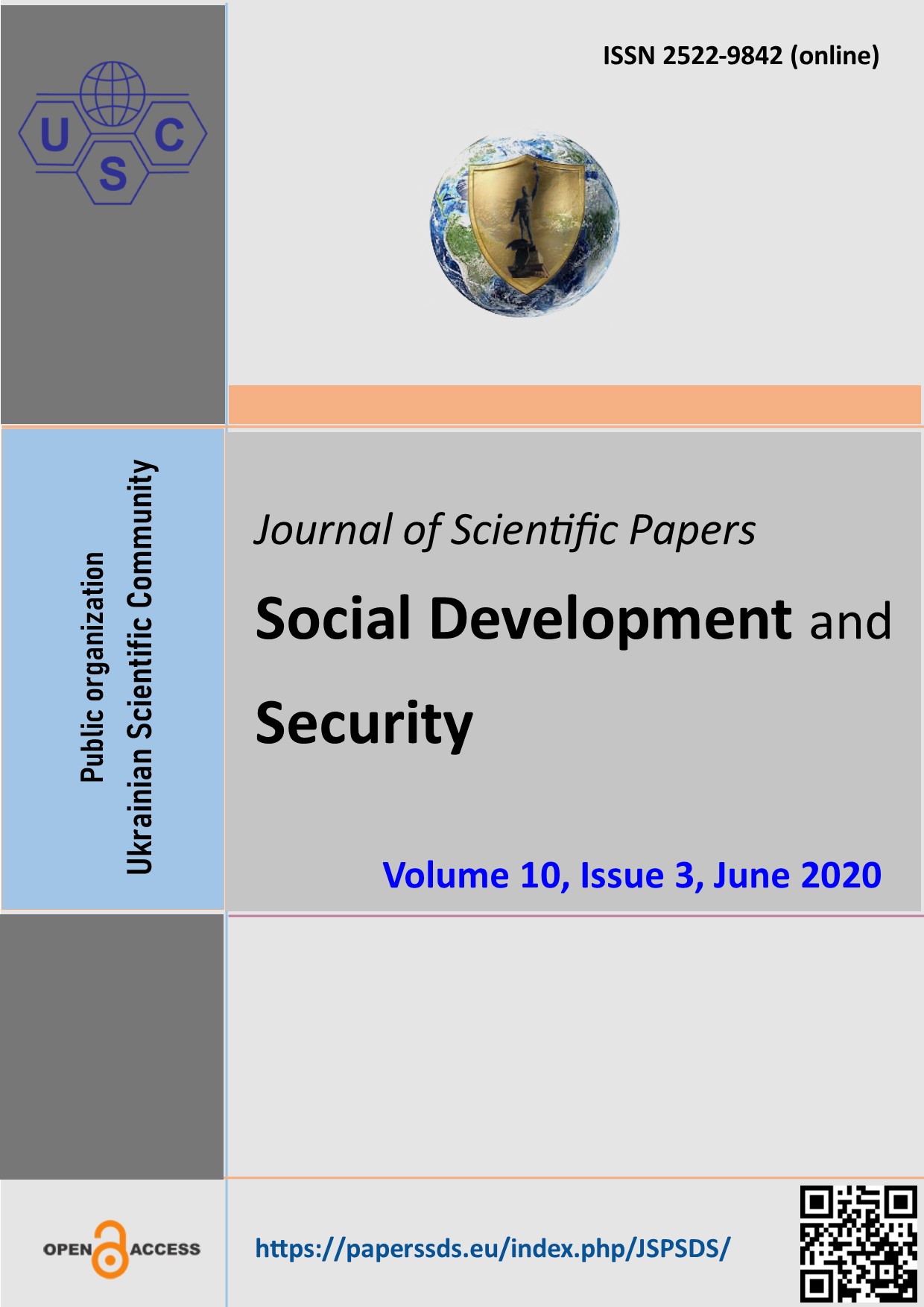Analysis of factors affecting the functioning of artillery reconnaissance control posts
Abstract
Typical trends in modern warfare, which directly affect the operation of artillery reconnaissance control points, can generally be considered: the transition to a network-centric concept of warfare; the growth of spatial scope and dynamism of armed struggle; globalization of intelligence, control and navigation systems; the growing role of information warfare, cybernetic actions in conflicts and wars of the future; reduction of timelines for preparation for military operations; ensuring a qualitatively new level of information compatibility of reconnaissance, control, navigation, command and control systems and various strike weapons and systems; integration of reconnaissance, destruction, control and electronic warfare means into electronic-fire systems, are provided with information and are managed in a time scale close to real. When assessing the effectiveness of the use of an artillery reconnaissance control point, it is necessary to identify the degree of dependence on objective and subjective factors, and establish a mechanism for their influence on functioning.
The article discusses the factors affecting the functioning of artillery reconnaissance control points, which are proposed to distinguish between external and internal. An analysis of their interaction.
The disruption of the functioning of the artillery reconnaissance control posts will lead to the impossibility of centralized control of the artillery reconnaissance system and individual intelligence agencies. Therefore, it is imperative to take into account the influence of these factors in order to function effectively and, accordingly, effectively fire the enemy with artillery as a whole.
The results of the analysis of these factors can be used in the formation of performance indicators for the functioning of artillery reconnaissance control centers.
An analysis of the interaction of forces and means of artillery reconnaissance and fire weapons of the leading, militarily, countries of the world provides an opportunity to study the development of weapons and military equipment to ensure the creation of reconnaissance and information subsystems of rocket troops and artillery.
Downloads
References
Osnovy teorii upravleniya voyskami / pod red. P. K. Altukhova. Moscow: Voyennoye izdatel'stvo, 1984. 222 s.
Verveyko B. M., Gul'bis S. K. Otsenka effektivnosti funktsionirovaniya sistemy upravleniya voyskami. Nauka i voyennaya bezopasnost. 2006. № 4.
Yarosh S. P. Teoreticheskiye osnovy pobuzhdeniy i zastarelykh rozovykh i informatsionnykh sistem prototipov oborony: monografiyaю Kharkiv: KHUPS, 2012. 512 s.
Magas G. A. Tendentsíí̈ rozvitku zbroynoí̈ botaniki u suchasnikh umovakh. Zbírnik nauchnykh prats' Natsíonal'noí̈ akademiií̈ Derzhavnoí̈ prikordonnoí̈ sluzhi Ukraí̈ni. Seriya: víys'koví ta tekhníchní nauki. Khmel'nits'kiy: 2015. №1 (63). S. 79-95.
Sovmestnaya publikatsiya 6-0 «Doktrina podderzhki sistem komandovaniya, upravleniya, svyazi i komp'yuternykh sistem (C4) dlya sovmestnykh operatsiy». 1995. 88 s.
Mozgoviy R. Analiza Chinnikova, kotoryy prinimayet vo vnimaniye effektivnost' funktsional'nykh sistem upravleniya i upravleniya pri operativnoy i / ili operativnoy rabote / R. Mozgoviy // Nauchno-issledovatel'skiy institut natsional'noy akademii derzhavnoy sluzhby Ukrainy. Seriya: víys'koví ta tekhníchní nauki. Khmel'nits'kiy: 2016. № 4 (70). S. 133-142.
Mikhalevich V. Ye. Analiticheskiy faktor, sposobstvuyushchiy effektivnomu funktsionirovaniyu informatsionnoy zablagovremennosti ASU. / V. Ye. Mikhalevich // Natsíonal'niy uníversitet oboroni Ukraí̈ni im. Ívana Chernyakhovs'kogo. Trudi uníversitetu. Zbírnik naukovikh prats'. 2018 №4 (149) S. 105.
Sholud'ko V. G. Organízatsíya víys'kovogo zv'yazku: navch. posíb. / V. G. Sholud'ko, M. YU. Êsaulov, M. O. Vakulenko, T. G. Rurskiy. Kyiv: MO Ukraí̈ni VÍTÍ, 2017. 281 s.
Artileríys'ka rozvídka: Pídruchnik / [P. P. Tkachuk. YU. Ê. Repílo, O. P. Krasyuk ta ínshí]. L'viv: ASV, 2014. 343 s.
Tkachenko V. A., Políshko S. V., Sokurenko V. V., Taranets' O. M. Analiticheskoye oborudovaniye i operativno-rozysknyye operatsii operativno-takticheskogo razvitiya i reabilitatsii v usloviyakh dosrochnoy podgotovki ATO (OOS) / V. A. Tkachenko, S. V. Políshko, V. V. Sokurenko, O. M. Taranets' // Natsíonal'niy natsional'nyy universitet oborony Ukrainy. Ívana Chernyakhovs'kogo. Trudi uníversitetu. Zbírnik naukovikh prats'. 2019. № 1 (151). S. 60-69.
Stuzhuk P. Í. Pedvishennya operativnoy artilleriyskoy roznitsy v oboronnoy operatsii armeyskogo korpusa. Distsiplina v nauke uchenoy stepeni kandidata nauk.
Adamenko M. V., Íl'yashov O. A. Otsenka operativnosti i funktsional'nosti sistem artilleriyskogo rozyska v Integral'nom tsentre protiv raketnykh voysk i artillerii / Adamenko M. V., Íl'yashov O. A. // Natsional'nyy nauchnyy tsentr Tsentrov voyenno-strategicheskikh issledovaniy NUOU imeni Ivana Chernyakhovskogo 2017. №2 (60). S.109.
Kulakov YU. A., Omelyanskiy S. V. KZO Komp'yuternyye seti. Vybor, ustanovka, ispol'zovaniye i administrirovaniye / Kulakov YU. A., Omelyanskiy S.V. K .: Yunior, 1999. 544 s., Il. Yarosh S. P. Teoreticheskiye osnovy pobuzhdeniy i zastarelykh rozovo-upravlyayushchikh informatsionnykh sistem prototipov oborony: monografiya / S.P. Yarosh; za red. Í.O. Kirichenka. Kharkiv.: KHUPS, 2012.-512 s.
Zagorka O. M. Vizanennya potríbnoí̈ kíl'kostí osobogo sklada ob'dnanogo komandnogo punkta ugrupuvannya víys'k / O. M. Zagorka, A. A. Korets'kiy, A. K. Pavlíkovs'kiy, Í. O. Zagorka // Natsíonal'niy uníversitet oboroni Ukraí̈ni im. Ívana Chernyakhovs'kogo. Trudi uníversitetu. Zbírnik naukovikh prats'. 2018 №2 (147) S. 35 – 43.
Abstract views: 605 PDF Downloads: 835
Copyright (c) 2020 Alexander Taranetc, Mykola Dorofeev

This work is licensed under a Creative Commons Attribution 4.0 International License.
The authors agree with the following conditions:
1. Authors retain copyright and grant the journal right of first publication (Download agreement) with the work simultaneously licensed under a Creative Commons Attribution License that allows others to share the work with an acknowledgment of the work's authorship and initial publication in this journal.
2. Authors have the right to complete individual additional agreements for the non-exclusive spreading of the journal’s published version of the work (for example, to post work in the electronic repository of the institution or to publish it as part of a monograph), with the reference to the first publication of the work in this journal.
3. Journal’s politics allows and encourages the placement on the Internet (for example, in the repositories of institutions, personal websites, SSRN, ResearchGate, MPRA, SSOAR, etc.) manuscript of the work by the authors, before and during the process of viewing it by this journal, because it can lead to a productive research discussion and positively affect the efficiency and dynamics of citing the published work (see The Effect of Open Access).
















